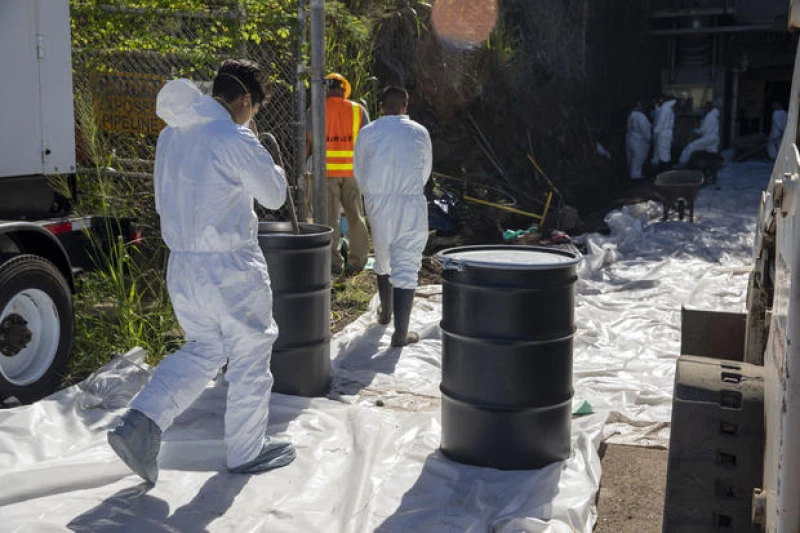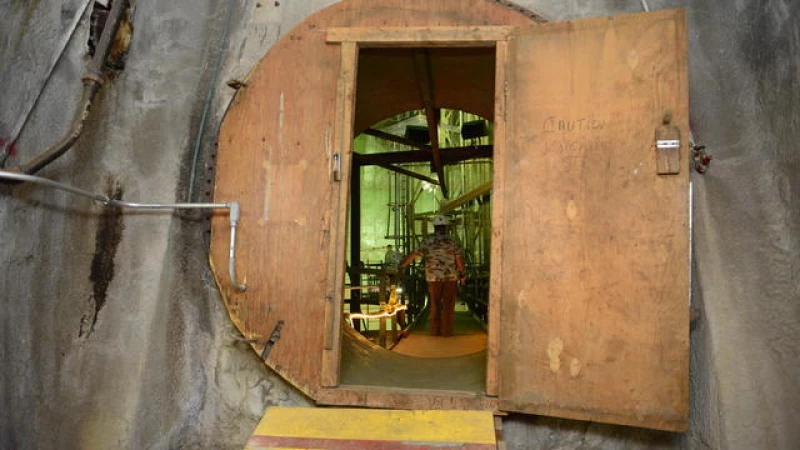The week of Thanksgiving in 2021 quickly turned from one of fun with family and friends to something described as "post-apocalyptic" on the Hawaiian island of Oahu. Jet fuel had unknowingly leaked from the Department of Defense's largest underground fuel storage facility and seeped into the system that provides drinking water to thousands of military families and area residents.
Within days, "we were all fighting over water," Mai Hall, who is Native Hawaiian and a military spouse, told CBS News.
"It was all over the neighborhood. … I was crying putting tape over the faucets because I just could not believe that I couldn't drink the water, water that has been here for centuries," she said. "...The system has failed us."
Hall's family is one of many still feeling the impacts of that jet fuel exposure even today. But that leak wasn't the first that has occurred at the U.S. Navy's Red Hill Bulk Fuel Storage Facility — and it wasn't the last.
Red Hill's Troubled Past and Ongoing Issues
Constructed in the early 1940s beneath a mountain ridge close to Honolulu, Hawaii's capital, the Red Hill Bulk Fuel Storage Facility comprises 20 steel-lined tanks encased in concrete. Standing at 250 feet tall and 100 feet in diameter, each tank has the capacity to hold approximately 12.5 million gallons of fuel, making them large enough to accommodate the Statue of Liberty from the base to the torch.
Ernest Lau, the manager and chief engineer of the Honolulu Board of Water Supply, revealed to CBS News that the Navy's records indicate a minimum of 72 documented fuel leaks from the facility. Lau stated, "Probably over 180,000 gallons of fuel of different types have been released over its 80-year history." The Navy Closure Task Force–Red Hill, responsible for the defueling and permanent closure of the site, informed CBS News that despite reports citing around 70 fuel leaks since the facility's establishment in 1942, the Navy has acknowledged 58 of these incidents following a 2021 Contested Case Hearing. The Navy is presently verifying the number of fuel and aqueous film forming foam (AFFF) releases—a fire suppressant containing PFAS, also known as "forever chemicals" associated with various health concerns, including cancer.

The most recent of those major fuel spills was in the fall of 2021, impacting Hall's family. Initial reports from the Navy indicated there was a spill of 14,000 gallons at this time, but it was later determined that 19,377 gallons of jet fuel spilled when a cart hit and cracked a fire suppression system pipe that had been containing the fuel since it leaked out of a tank earlier in the year.
But two years before that, a risk analysis conducted by the Navy found a 27.6% chance "of an initiating event resulting in a fuel release between 1,000 and 30,000 gallons."
That analysis was conducted after a spill was announced at the facility on Jan. 13, 2014, which at the time was holding three types of fuel — JP-5, JP-8 and diesel marine fuel, all of which are known to be harmful to human health when chronically exposed. The leak occurred when one of the underground tanks "experienced a release of 27,000 gallons of fuel due to a contractor's error and an ineffective response and oversight," the Navy says on its website.
The EPA wasn't verbally notified until three days later and written notification to the EPA wasn't issued until 10 days later.
"They didn't even know that a spill had happened until someone actually checked on the tank and noticed that there was about a foot and a half of fuel that was missing," Kamanamaikalani Beamer, a professor at the University of Hawaii Center for Hawaiian Studies, told CBS News. At the time, he was serving on the Water Resource Management Commission.
"The tanks are severely corroded," a concerned individual stated. "I mean some of them, less of the thickness of a dime is the barrier between 100 million gallons of fuel and leakage."
A task force informed CBS News that "all fuel tanks experience corrosion" and that the Navy employed "several strategies" to combat it, such as tank cleaning, inspection, and repair, a process known as TIRM.
Following the spill, questions were raised by Beamer, who interacted with Navy officials during meetings with the commission regarding the extent of the issue and how it could have occurred. He believes the incident was "probably the first large-scale spill that really caught everyone's attention." Despite the Navy eventually agreeing to an Order of Consent with the health department, EPA, and others, the commission still harbored concerns about its success, Beamer disclosed.
"They assured me this would never happen again. This was just because of one faulty tank and they were going to come up with a whole system to fix the tanks," he expressed. "...They assured me it was the most state-of-the-art facility. They looked me in the eye and told me … 'We drink from the same aquifer as everyone, we would never poison our own people.' And they lied, they lied about all of it."
"Our commitment to environmental stewardship is unwavering," remarked Capt. Mark Wheeler, who was the commanding officer at the time of the incident at the Fleet Logistics Center Pearl Harbor. "The well-being of our military personnel and their families, who both reside and consume the local water, is of utmost importance."
Notably, the 2014 spill was just one of the incidents involving Red Hill and other Naval activities.

"There were numerous red flags," stated Wayne Tanaka, the director of the Sierra Club of Hawai'i, in an interview with CBS News. "Despite the intense scrutiny on the Red Hill facility, the Navy repeatedly failed to operate in an environmentally and socially safe manner."
As early as 2017, the EPA had raised concerns about the facility's outdated infrastructure posing a "significant environmental threat" to Oahu's groundwater.
In 2012, the Hawai'i Department of Health (DOH) fined the Navy Public Works Center Makalapa Compound $80,000 for failing to properly handle hazardous waste. The inspection revealed that corrosive wastes were not classified as hazardous and were disposed of in the trash. Additionally, hazardous paints and fuels were stored in open containers, violating regulations.
An emergency order issued by the Hawai'i DOH in December 2021 highlighted further issues at the facility. In 2020, there were two instances of a regulated substance being released into surface water. In May 2021, 1,618 gallons of fuel leaked from a pipeline, with only 1,580 gallons recovered, leading to environmental contamination. Subsequently, 150 gallons of a regulated substance were released at Kilo Pier, with a partial recovery.
The emergency order expressed concern about the frequency of incidents at the facility, especially in light of the recent drinking water contamination. The U.S. Navy, as the respondent, was urged to take immediate and appropriate response actions to prevent further harm to the aquifer system.
Despite long standing issues, Tanaka said it wasn't until the November 2021 incident that local and federal officials took significant action.
"And that's really scary because we can't afford to have another incident like this happen again," he said. "...The state has likened [Red Hill] to a ticking time bomb. … So the threat is immense. The threat is existential."
As fuel spill victims head to trial, Navy continues effort to shut down the site
On Monday, victims who were impacted by the 2021 fuel contamination headed to trial to seek financial compensation from the U.S. government. Many of those who drank, bathed in and used tainted water for dishes and laundry say they are still dealing with various health impacts, including children.
The trial comes just under a year after attorneys for the Department of Justice filed a joint stipulation that stated "the United States does not dispute" the 2021 spill "caused a nuisance" and that the U.S. "breached its duty of care to the Resident Plaintiffs to exercise ordinary care in the operation of Red Hill."
Following the 2021 spill and an additional leak of AFFF in 2022, the Department of Justice (DOJ) has mandated the permanent closure of the site. As of April 2024, the task force informed CBS News that "the vast majority of fuel and AFFF concentrate have been removed from the facility." Despite this progress, there are still thousands of gallons of contaminants that persist on the site.
The task force revealed that approximately 28,000 gallons of sludge are present in the 14 tanks. This sludge comprises a mixture of fuel, water, dirt, metal particles, and microorganisms that accumulate at the bottom of fuel tanks. Once extracted, it will be stored in hazardous waste containers for disposal on the U.S. mainland.
Additionally, an estimated 4,000 gallons of residual fuel need to be eliminated from pipelines spanning nearly 10 miles, according to the task force.
"Our team is committed to removing the residual fuel prior to extracting small sections of pipe, while strictly adhering to safety protocols for each operation. The environmental risk has significantly decreased following the removal of approximately 104 million gallons of fuel during defueling, along with the recent extraction of over 1,000 gallons of AFFF from the site," stated the task force, emphasizing the substantial threat the AFFF posed to the aquifer.
The task force anticipates commencing tank cleaning operations soon, with a plan to clean two tanks simultaneously. The cleaning process is projected to span around 2 and a half years. Similarly, the removal of the pipeline system is expected to require a similar timeframe of about 2 and a half years.
The Navy's task force emphasized the top priority of ensuring the health and well-being of all users of Navy drinking water. They reaffirmed their commitment to maintaining the quality of the water and ensuring compliance with all state and federal safe drinking water standards.







